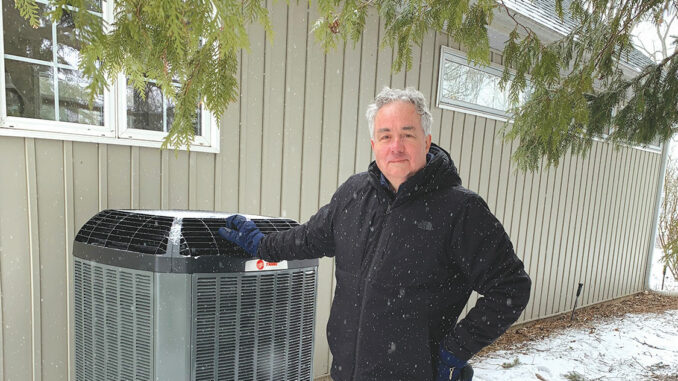
In May 2019, I wrote an article suggesting Leaside become one of the greenest neighbourhoods in the country. It’s always rewarding when Leaside Life readers reach out. Tim Short, who has lived here for 28 years, did just that.
He wrote, “I am a resident of South Leaside and am very interested in the environment and the steps our society needs to take in order to get a better handle on our future. … Sometimes I feel like the environment is in a losing battle, but there are signs that things may be changing.” So, I wasn’t surprised after our editor assigned me this story to find it was Tim and his business partner Richard Laszlo (www.laszloenergy.com) who were promoting some new thinking about the good old heat pump. Thinking that couldn’t come at a more opportune time as we face soaring energy prices and challenging greenhouse gas emission (GHG) targets.
In 2018, Natural Resources Canada (NRC) reported that 52 per cent of Canada’s residential heating was produced by natural gas and that our homes produced 43.3 megatonnes of CO2 from space heating with the majority of these harmful emissions (61%) emanating from natural gas. Queue the heat pump. Heat pumps themselves do not generate heat, instead, they move heat from one place to another with the help of electricity. They take in heat energy from the outside air and transfer it indoors. Conversely, they can also function as air conditioning systems by absorbing heat from the indoor air and transferring it outside.
Awareness gap about the performance of cold climate heat pumps
A study published in Dec. 2021 by Heather McDiarmid for Ontario Clean Air Alliance Research notes there is a “gap in consumer and industry awareness of the performance and reliability of cold climate heat pumps.” She notes that heat pumps are a highly attractive option that provides major efficiency gains, and consumers are most likely to install high-efficiency heat pumps when they are replacing their old air conditioning units. If Ontario is going to hit its target of reducing emissions by 30 per cent over 2005 levels by 2030, then we would be wise to pay attention to the strategies in Ontario’s Environment Plan, which includes a commitment to encourage the use of heat pumps, along with Toronto’s TransformTO climate action plan that calls for fuel switching all buildings to “electric heat pumps or alternative sources of low emissions heating.”
Tim points out that we all have heat pumps in our home today – in the form of a refrigerator, a freezer and an air conditioner. The key insight here is that these versions of a heat pump are designed only to cool (i.e., a one-directional heat pump). Typically, if you were to replace your furnace and air conditioner with a pump that is capable of both cooling and heating, the cost is significant (e.g., $20,000). Tim says “this approach is a non-starter.” The game-changing thinking that Tim and Richard are highlighting is about a hybrid way to deploy a heat pump. In a hybrid system, the air conditioner is replaced with a heat pump. The heat pump is used the majority of the year and the gas furnace only kicks in when the temperature dips below a pre-set level.
Since most homes in Leaside have a natural gas-fired furnace, Tim explained the procedure to switch to a hybrid solution would involve an installer who opens up the top of the blower box just above the furnace, pulls out the cool-only heat exchanger and installs a heat and cool exchanger so it can accommodate a heat pump that’s going to send cool air in the summer and heat in the winter. It keeps the same refrigerant lines. It keeps the same power line going to the air conditioner. It keeps the same furnace. It keeps the same duct system. All of that stays exactly the same. What changes is, of course, the heat pump so you’ll need a smart thermostat if you don’t already have one. “This is a very attractive solution,” he says.
Think about this for a minute: Switching to a heat pump is the equivalent of taking a gas-powered car off the road.
Leasiders who are facing the prospect of replacing their air conditioner should strongly consider the estimated $3,000 incremental cost of replacing it with a heat pump capable of both heating and cooling. With a lower initial capital cost, the case for adding the benefits of a heat pump becomes much stronger. In addition, it will improve over time because there is a $15 per tonne incremental increase every year on the price of carbon which gets added to the cost of natural gas. When coupled with energy price shocking events such as the Russia-Ukraine war, the effective price gap between electricity to operate the heat pump versus natural gas will continue to shrink.
If the economic case is looking brighter, then the environmental case for swapping out your air conditioner for a heat pump is brilliant. Tim told me there are approximately 250,000 air conditioners installed every year in Ontario because they wear out. He emphatically states that “nobody should be installing another traditional air conditioner ever again; it should be a heat pump.” According to Tim’s calculations, a typical detached home in Leaside could eliminate approximately 1.8 tonnes of carbon per year by using a heat pump. As I said before, this would be the equivalent of taking one gas slurping car off the road. A result certainly much cheaper than buying an electric vehicle!
With spring in the air and summer just around the corner, if you are considering replacing your air conditioner, it would be a mistake not to investigate the benefits of a heat pump before you make your final decision. As an added incentive, NRC’s Canada Greener Homes Grants are available to help Leasiders make their homes more energy-efficient by offering up to $5,000 for qualified heat pumps to help homeowners make energy-efficient retrofits to their homes. Encouraging homeowners to switch away from furnace oil and natural gas produces a significant reduction in GHG emissions, and every new heat pump installed in Leaside will make us greener.
Are you considering the benefits of a heat pump for your home? Are you aware of other impactful solutions that can help Leaside become one of the greenest neighbourhoods in Canada? Let us know at


